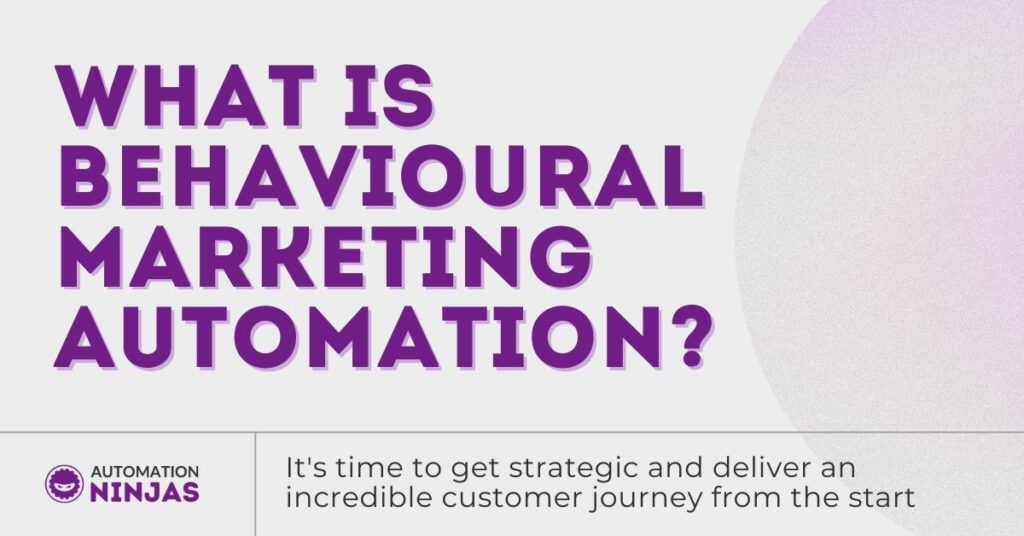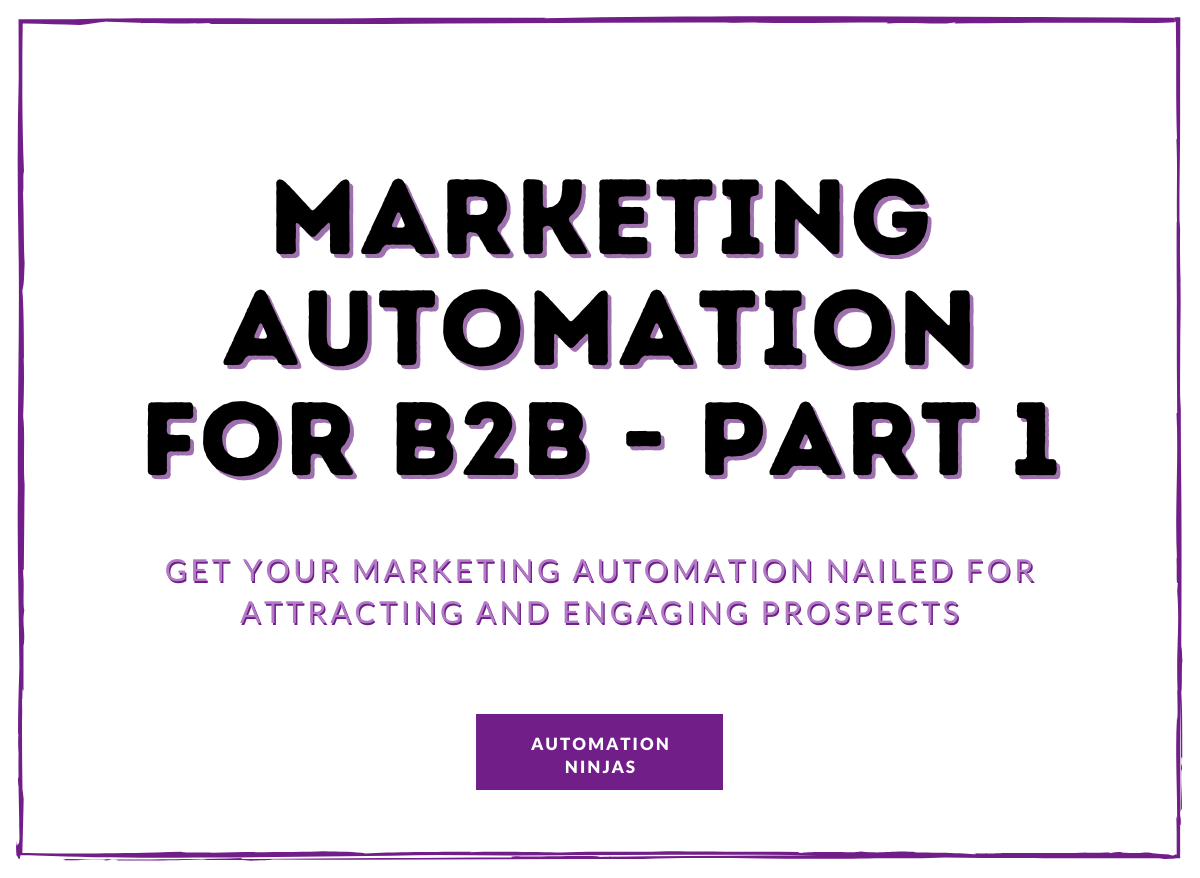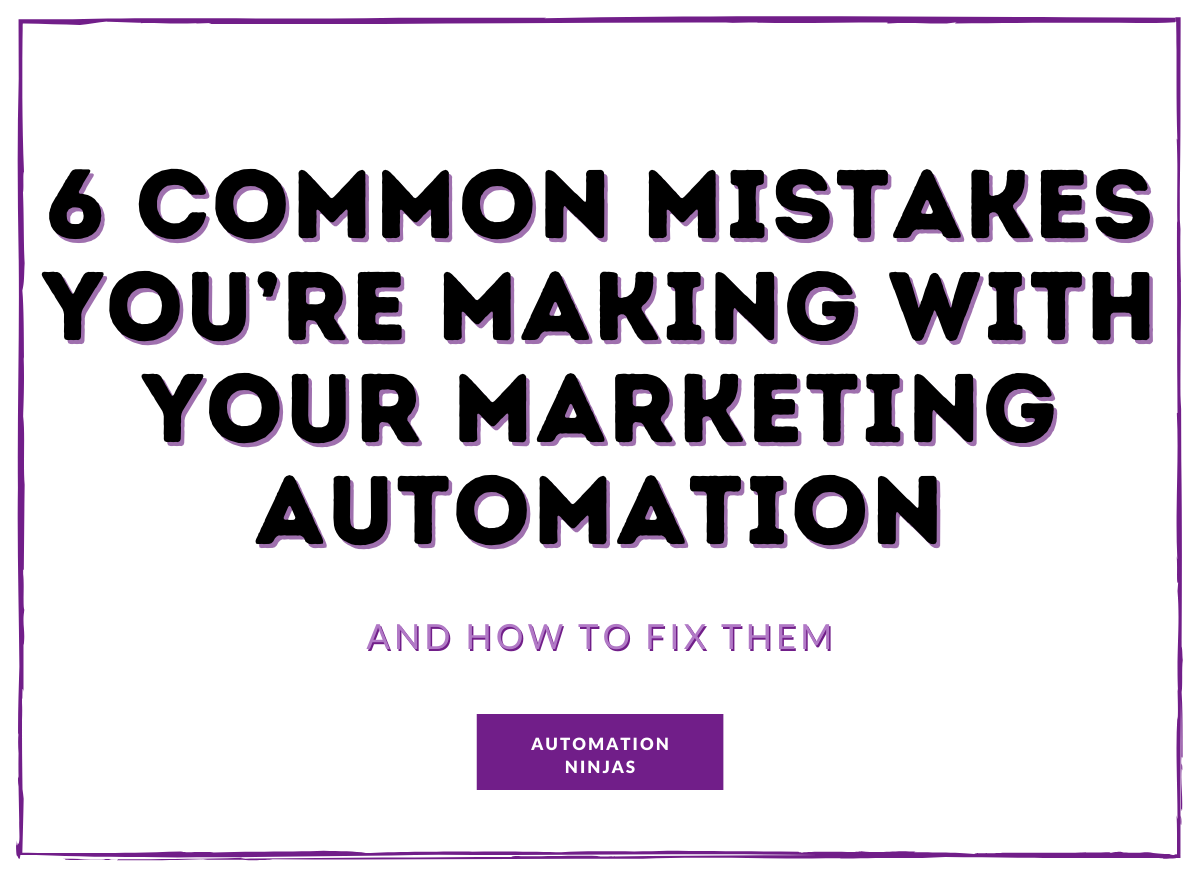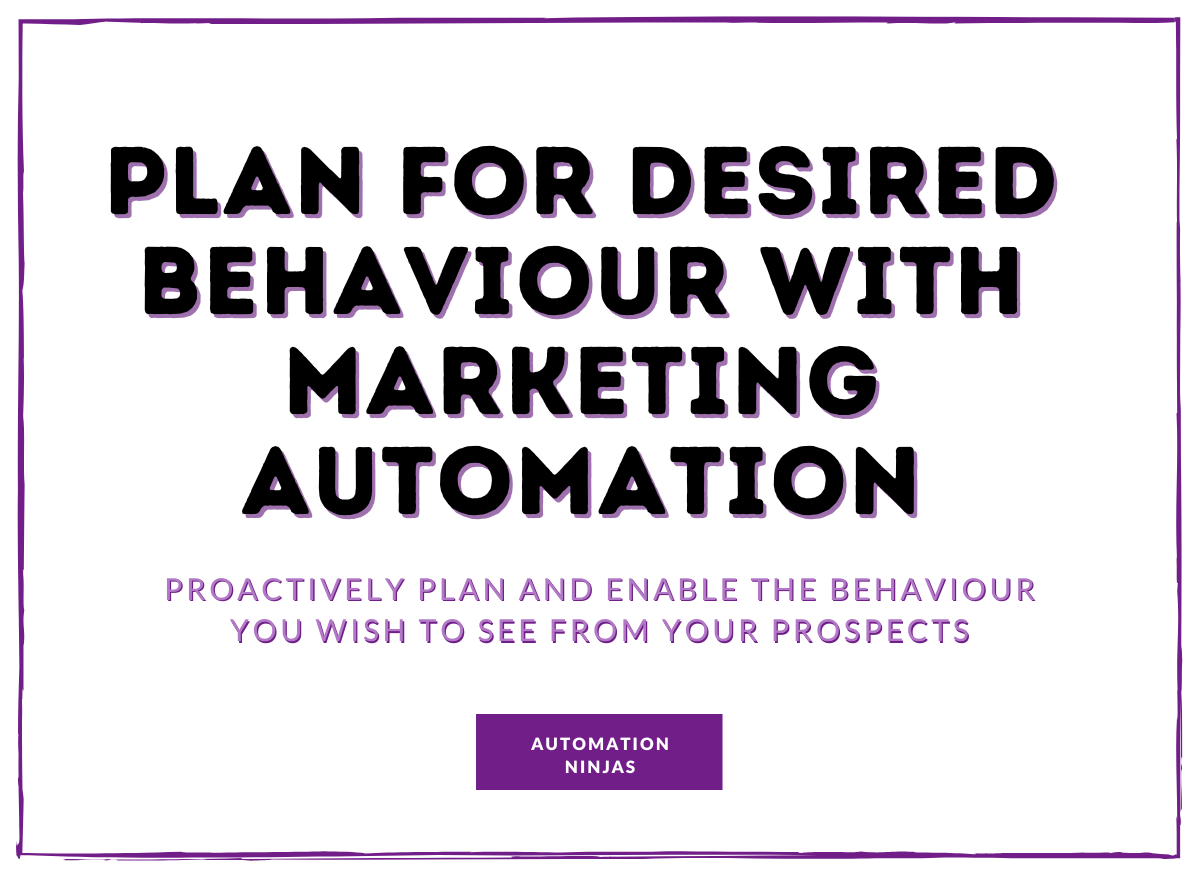Author: Ashton Oldham
Hey there, I'm Ashton, the Content Ninja with a penchant for creativity! I'm all about crafting killer customer-focused content and sprinkling it with that special sauce that makes brands pop. Teaching, strategising, organising (people and projects), and spicing up collaborations? That's my jam!
Unless you've been living under a rock (I see you Patrick Star), you’ll have come across marketing automation before. You’ll either be on the receiving end, have it implemented in your business, or both. What you might not be as familiar with is behavioural marketing automation.
Behavioural Marketing Automation uses standard marketing automation and adds in buyer psychology and behavioural science to enhance it.
That’s it in a nutshell. However, if you know us Ninjas, we never leave it at that 🙂
Let’s quickly address buyer psychology before we dive into the marketing automation wormhole. After all, it’s what drives any successful marketing strategy.
Buyer psychology is about understanding why leads and customers do what they do. If we know why they do something, we can plan for it.
As we state in another blog, "Buyer Psychology allows marketers to have an understanding of what certain behaviours mean."
We are looking at how and why people make decisions. This knowledge will then guide us on what choices we make as marketers. It's powerful stuff!
If you want to go deeper into understanding Buyer Psychology, here's a link to that blog.
Now, let's get into why you are here.
What is behavioural marketing automation?
As I stated, it's standard marketing automation, but with a healthy dose of behavioural science added in for good measure. In short, it’s a way to automate but a little more intelligently.
Behavioural marketing automation is about understanding human behaviour, as well as how this influences our customer’s purchase decisions.
Behaviour is the thread we pull on to unravel the problem of customer experience. It allows you to quantify and understand how experience is perceived, increases value and rewards activation and ultimately allows you to create a better customer experience.
And if we can quantify a problem, we can design processes to solve it.
Behavioural automation leads to better quality leads, higher conversion rates and longer customer lifetime value. McKinsey states, "businesses that leverage data outperform their competitors by 85% in sales growth and more than 25% in gross margins".
So it’s something we are keen to help people understand and utilise in their business. Because if used properly, it can help to transform a business.
Are you with me, or is your brain starting to morph into a scrambled egg?
If you are thinking, “Woah there, Nelly. I’m not even sure what marketing automation is, let alone all the behavioural stuff”, don’t worry—I’ve got you covered. I’ve popped some foundational content about marketing automation further into the blog,
Have a read of that, and you’ll get clued up in no time. Click here to skip to the foundational content.
If you feel confident in your marketing automation knowledge, I’ve got a nice little video to share.
Kenda, our CEO & Psychology expert, recorded it a little while back. She explains behavioural marketing automation incredibly well, even for those of us (including myself pre-Ninja) who wouldn’t know buyer psychology from a toad.
Take a look!
Applying Behavioural Marketing Automation to your overall strategy
We are big fans of using data and information around an individual's behaviour to tailor the automation process. It makes for a much more targeted and personalised experience, and ultimately this builds trust and translates into increased revenue.
We build out behavioural marketing automation campaigns around the Customer Journey flywheel - with customer needs at the heart of it.
Need to get yourself up to scratch on customer journey's? Head over to our blog to do just that!
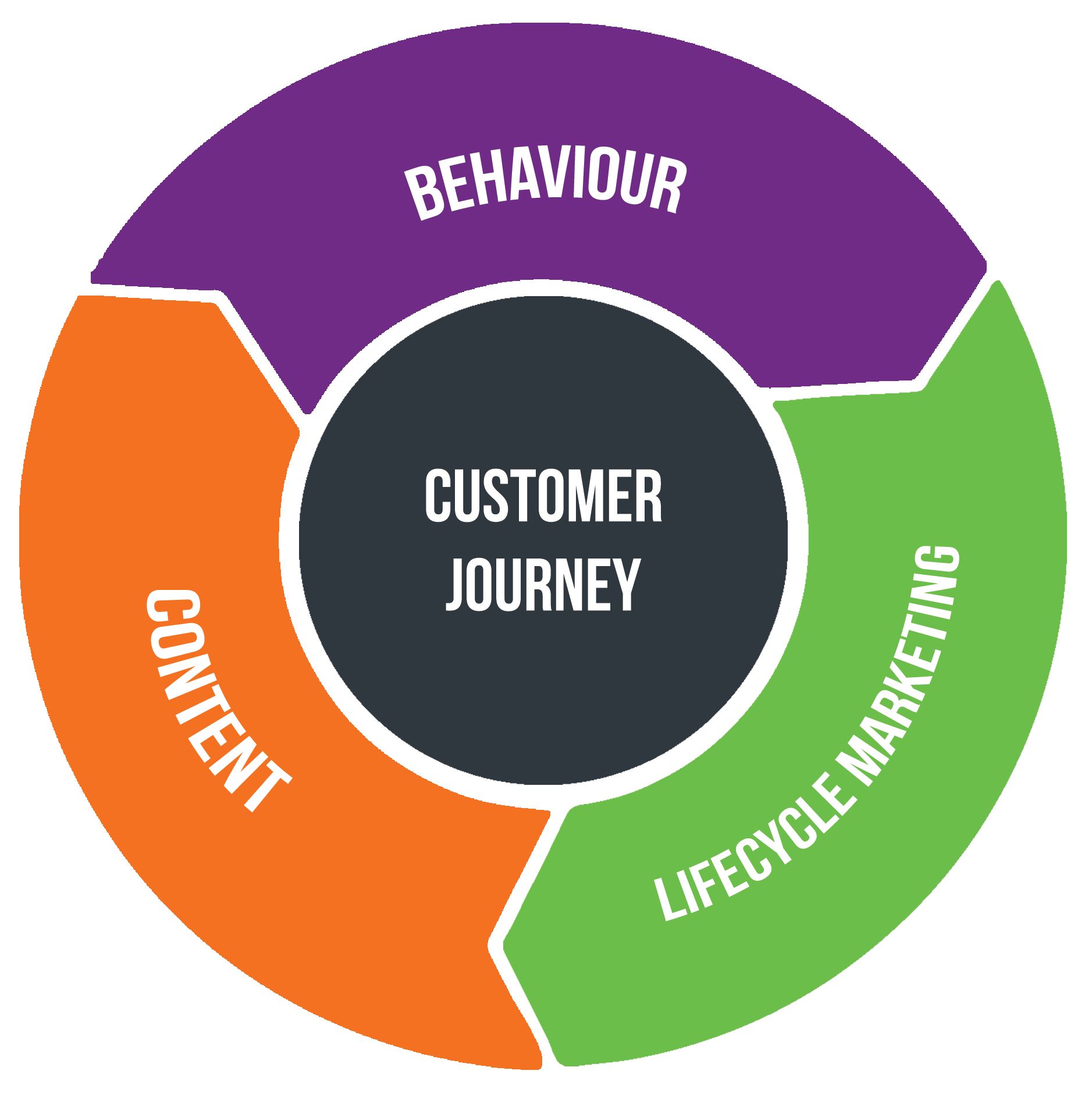
The book Leading on the Edge of Chaos, suggests that companies that prioritise customer experience generate 60% higher profits than their competitors.
So how exactly do we place customers at the centre of the flywheel and use behaviour to inform each step of the process?
Using Lifecycle Marketing as a base structure…
Lifecycle Marketing is the secret sauce to good marketing. In particular, it allows any business, no matter their industry, to define and build a journey for their customers to continually delight them.
Our lifecycle marketing framework consists of four stages:
- 1Attract
- 2Engage
- 3Sell
- 4Wow
We structure our behavioural marketing automation and customer journeys on that effective framework.
Though engage has it's own stage, and rightfully so, engage comes into every other stage too. Engagement is where the behaviour happens.
Each stage can be broken up even further. There are some critical things that need to take place - let's briefly touch upon them.
Attract - Target
You need to clearly understand your target market. There will be distinct groupings of people, we tend to call these segments. Each segment will have differentiators and therefore require a different approach.
To create your segments, you need to get started with come progressive customer profiling.
What's really great about segmentation and progressive profiling, is it gives you the means to be more personalised in your messaging. Almost as though you are speaking to each one of that segment individually. This will give you far more impact than if you were to blanket message a large mixed group.
Attract - Drive Interest
Once you are clear on your segments and what makes them tick - their wants, needs, preferences etc. you can get to work on attracting them to your business.
You'll do this through clever content.
From blogging on a regular basis using SEO strategies, to targeted ads and social medial posts, you can drive traffic to your website. It's here that you need to stand out with something that will draw them in for more. You need to give them content they want to consume, and you need to offer lead magnets.
Psst. not sure what a lead magnet is? Check out 'What is a lead magnet?' for more.
Attract - Collect Leads
There's zero point driving traffic to your website if you aren't collecting those luscious leads. And for the love of Zeus, please make sure you automate this process. You should have sign up forms littered throughout your site, showcasing a variety of "I want that" offerings.
It's a trade off. You offer something of high value and they give your their contact info (first name & email), plus the permission for you to contact them with all the good marketing stuff. (And yes, it must be good.)
You'll want to have a CRM system / email marketing platform that connects with your sign up forms. Get all of that automatically operational, and then the fun can really start. Engagement.
Engage - Educate and Nurture
Once you've done the work in getting a lead into your marketing list, it's time to build a trustful relationship with them. Relationships are a two way street. They are based on a bit of give and take. So, don't expect to just take (their money) without giving them something first.
In this case, you need to give them value. Proof on why they should trust and like you. Its time to nurture the heck out of your new leads. And, you're going to do this with content.
See 'How to add value to your content' for the lowdown on the good stuff.
The educate part is to help them understand what their problems are, and get clear on wants and needs. You're also educating them on how you can help them, and showcasing your expertise. By educating them, you are helping them to move through each stage of awareness.
Eventually moving them to the next stage of the marketing lifecycle: Sell!
Sell - The Offer
After nurturing the socks off your leads, and getting them from Unaware all the way to Most Aware - they are primed and ready for purchase. That means you have taken them from unknown to MQL to SQL. And that takes work (so well done you).
Now you can go in with the offer. It needs to be based on everything you have learned about the prospect (thanks to tracking their behaviour and engagement). Make it personal. Make it about them. Make it hard to say no to!
(For those who need some foundational Marketing Automation info…)
What is Marketing Automation?
Simply put, Marketing Automation is everything you do to get and keep a customer, leveraged through the power of automation.
It’s all about using software to automate your marketing activities to provide a more efficient and personalised experience.
It can be used for a wide range of business activities. Let’s dive into that now.
- A collection of tools capable of delivering your content in an automated way across any or all of your chosen channels. Eg: email, social, sms, direct mail, apps, ads.
- Software that allows you to react automatically to engagement with that content - An email was opened, a link in an SMS message was clicked, a prospect saw an advert in a magazine and texted your keyword to your SMS number.
- A way of streamlining your sales and marketing teams, to reduce manual tasks and increase the chance of conversion to a customer.
- A platform that can take all your incoming leads and segment them based on their interest
- A tool that enables you to link your CRM to your advertising platforms to give a more personalised and highly targeted collection of messages.
- A method of simplifying the customer experience, reducing the number of steps involved in a purchase, scheduling content to be there at the right time, with the right message, and on the right channel.
- A nifty widget to act on those contacts that are engaging the most: Lead Scoring. How hot your leads are
- A system that gives you business intelligence, allowing you to gauge the engagement of your prospects and customers. Report on your sales; telling you which channel delivers the best customer lifetime value, and measure the success of your sales and marketing team’s efforts as a whole.
- An integration with your other tools, like your project management system, your internal communication system, your fulfilment company, or just your printer.
Marketing Automation Software
In no particular order, some examples of marketing automation software:
These systems can help you improve your customer journey, but not all of them will be necessary for your business. That's why it's crucial to map out your ideal customer journey first - go to our blog 'What is Customer Journey Mapping' to learn more about that.
You'll find that some features you need are included automatically in the software, but others will require a plugin or integration - such as Zapier.
Factors that will affect the price of the software
- The amount of features, remembering that you don't need them all to start with!
- The amount of contacts that you have in your database; your 'Email Marketing List'
- The amount of emails that you will be sending on a monthly basis
- How many users there will be that will login to the software, including a sales team if you have one.
Have these stats to hand before you do your pricing comparisons.
What Marketing automation can do
With effective marketing automation, you can combine all relevant channels with branded and cohesive content to increase the effectiveness and range of your message.
There have been many studies and many subsequent opinions on how many touchpoints are needed to create enough trust to make a sale, but the general concensus is that it's at least 6, and some people say up to 24.
In marketing it's good to be omnipresent. Your prospective buyers are certainly not just living in their inbox all day.
With decent marketing automation software, you could be reaching them on:
Email
Sms
Social
Mobile
Apps
Offline - Leaflets, Magazines, billboards
Webinars
Events
Networking
Conferences.
PDF downloads
Checklists
Guides
Free training
Short video series
Survey results
Cheat sheets
Quiz
Top 5 strategies for achieving something
First chapter of your bestselling book
Affiliate offer
Swipe files and templates
Free trial of your membership or app
Case studies
Free consultation
Learn more about lead magnets here: What is a Lead Magnet? / How to Create Strategic Lead Magnets.
- Email clicks
- Lead magnet downloads
- Visits to web pages
- Web page button clicks
- Cart abandonment
- Clicks on SMS messages
- Webform submissions
- Webinar attendance
- Event attendance
- Video views, and time viewed.
- Lead Scoring - How many times do they perform the behaviours above?
- Segmentation - Which particular downloads did they go for, which emails did they click on? Where are your leads located?
- AB testing - What time of day do they open most, more or less images? Which email subject got the most opens? Video, or PDF?
- Predicting next behaviour - What have previous campaigns succeeded in, and failed at?
- Dynamic content - Show your prospects only content that they are interested in, and leave out the type of content they have ignored before.
- Notify the sales team that they have interacted and have visited your product page.
- Add value with content upgrades and latest developments
- Help your prospects get to know you with team introductions
- Use videos to tell your story and explain why it relates to your prospects
- Build trust with testimonial delivery, e.g. videos, case studies, screenshots, Trustpilot ratings
- Create a personalised journey so you are talking directly to them
- Request feedback to make your audience feel more involved
- Create a member area to build community
- Educate your audience on a subject so that they make more informed decisions and move customers along their awareness journey.
- Send a thank you email when a purchase is made
- Give your buyers essential information on their new purchase, and how to get the best from it
- Follow up on free trial completion
- Request a testimonial or customer feedback
- Send an automated email from customer service when a query is made on your site
- Qualify your leads based on criteria that you set, and survey them for their interest and status
- Request a new credit card when a payment fails
- Use chatbots on your page to answer FAQ’s
- Sales pipeline automation - assign a prospect to a team member, and give them essential information, send an email or an SMS automatically if a call is missed, or contact is not made
- Remind your customers of an upcoming appointment or Zoom call
- Produce reports and dashboards on your KPIs, including customer lifetime value
- Ask for referrals - WOM is super powerful
- Social media posts - many platforms now automate this, our favourite is SmarterQueue
- When a quote is sent but not signed off, follow up to see if they have read it, or have questions.
- Campaign conversions - landing pages, form completions, downloads
- Cost per lead, cost per click, cost per transaction
- Sales reports - orders per month, average order value, customer lifetime value, cart abandonment figures, ROI
- Engagement - email opens, clicks, most engaged contacts, 1/3/6 months unengaged, unsubscribes, most popular types of content, engagement funnel
- New leads, lead to MQL, MQL to SQL, SQL to customer
- Social reporting - impressions, likes, shares, comments, follows, clicks to landing page
- Website reporting - pageviews, goal tracking, time on page, bounce rate, exit rate
- Most successful channels - Ads/PPC/CPC, email marketing, organic, referrals.
- Set up a welcome campaign for new subscribers
- Onboard new customers with helpful information
- Send follow up emails on the back of a lead magnet download
- Send abandoned cart emails and re-target on social or Google Ads
- Notify your sales team when people are most likely to buy (SQL - Sales Qualified Lead)
- React to engagement with your website, know when people visit your sales pages
- Send a further information email when you scan in a business card
- Send a monthly newsletter, weekly/bi-weekly long term nurture campaign (i.e. new blog content)
- Upsell and cross-sell on a purchased product.
Want to scroll back to the Behavioural Marketing Automation section and read what you skipped? Click here!
Ready to get stuck into Behavioural Marketing Automation?
I hope from reading this blog you can see why behavioural marketing automation is a must.
Without these strategies, systems and processes in place, there will always be a lack of effectiveness. You are marketing and selling to humans, with a human brain. Doesn't it make sense to learn a little about it and use that knowledge to boost your chances at lead generation and conversion?
If you have minimal automation in place, or your strategy isn't ticking any boxes, then the thought of doing everything that needs to be done can be mega overwhelming.
Where do you start? How do you implement it all correctly?
If you are going at it alone, we would suggest you focus on your weakest area. For example
- If you struggle to attract high quality leads - focus on the attract stage and create some lead magnets.
- If your engagement drops off, or your struggling to get a lead marketing qualified (MQL) - focus on engagement with nurture and education.
- If you have lots of leads that aren't qualified - you want to take them from MQL > SQL, focus on engagement and sell.
- Not converting? Focus on how to sell with the customer at the heart of your messaging.
- Poor CLV (customer lifetime value) focus on wowing your customers - onboard them brilliantly, and introduce them to other high value products or services. And always, always, continue to nurture.
Got a specific challenge or a project you want to work on, get in touch today.

